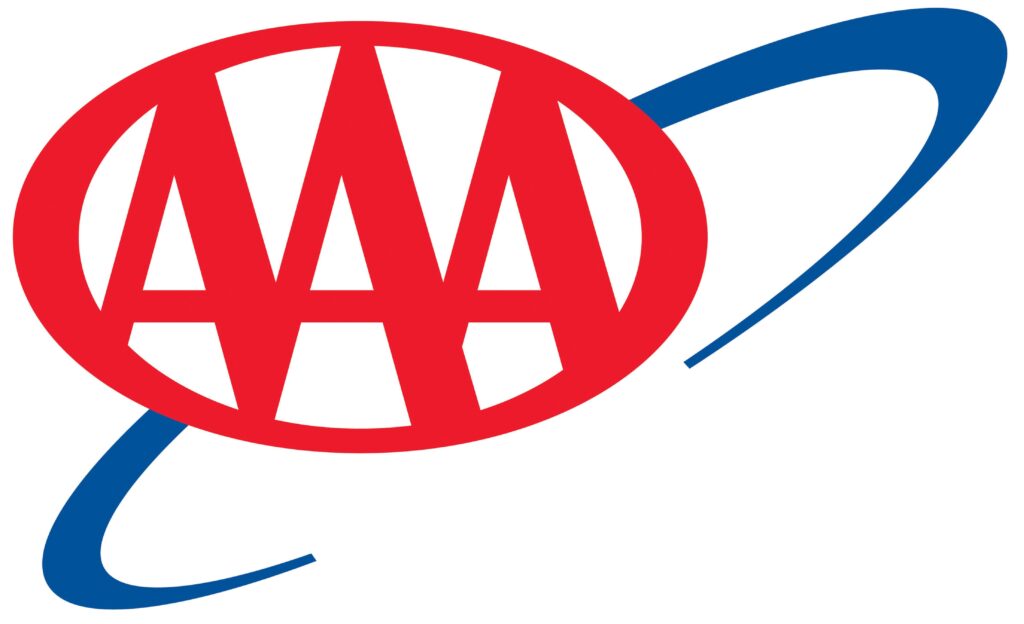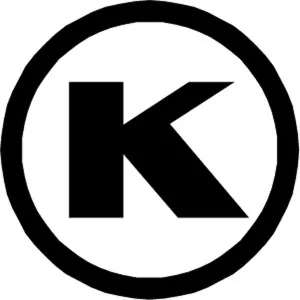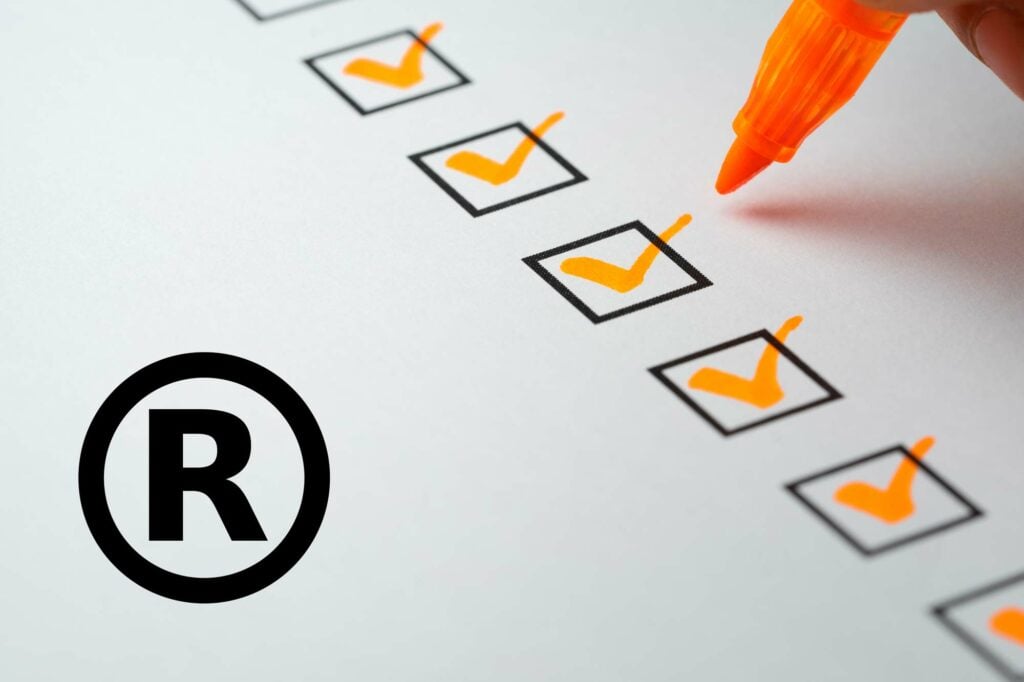Before you consider trademark requirements or filing a trademark application, it is important to first understand what a trademark is and what it protects. A trademark can be any word, phrase, logo, symbol, design, or expression used to identify the source and origin of goods and services. Take for instance the internationally recognized apparel brand Nike. You can identify that a clothing article, say a t-shirt, is a Nike product by looking at the tag.
The Nike wording or swoosh logo, both registered trademarks, may not be shown anywhere on the shirt but clearly visible on the tag to let consumers know that Nike is the source of goods. Trademarks help distinguish your brand from competitors and ultimately help protect your brand’s recognition and customer good will that you will continue to build over time.
It is important to note that registering a trademark through the U.S. Patent and Trademark Office (USPTO) does not provide legal ownership of the registered phrase or word. It is possible for competing business owners to use the trademarked phrase or word without breaking any laws. Take the brands Dove and Dove, for example. One is for chocolate/food products while the other is for bath care products. It will be discussed later why identical names can coexist.
Different Types of Trademarks
It is important to note that some things, although associated with goods and services, cannot be trademarked: generic terms, phrases, descriptive names, government symbols or insignias, vulgar or disparaging words or phrases, or proper names or likenesses without consent.
As defined by the USPTO, descriptive trademarks are marks that “merely describe some aspect of your goods or services without identifying or distinguishing the source of those goods or services. They’re only registrable in certain circumstances, such as your trademark gaining distinctiveness through extensive use in commerce over many years.’’ An example of a descriptive trademark would be “Cold and Creamy” for a company selling ice cream.
See the USPTO’s page to learn more about what makes a “strong” trademark.
While there are different strengths of trademarks, there are also different types of trademarks such as collective and certification marks and trade dresses. Collective marks are trademarks owned by an organization and used by its members to identify themselves with a level of quality or accuracy, geographical origin, or other characteristics set by the organization. An example of a collective mark is the AAA® mark, below, to indicate membership in the American Automobile Association.

Another type of trademark is a certification mark. A certification mark on a commercial product indicates the existence of an accepted product standard or regulation and a claim that the manufacturer has verified compliance with those standards or regulations. An example of such a mark, below, is stamped on the packaging of certain food products to indicate that the product is kosher.

Trade dress are another type of trademark that can be used to protect other source identifiers such as product packaging, the color, flavor, or scent of a product, and even restaurant or store layout. Famous examples of successful trade dresses include the red-sole of a Christian Louboutin shoe or Coca-Cola’s glass bottle. Trade dress does not safeguard the product’s function yet protects the display of the product to consumers as a source identifier.
Importance of Trademarks in Business
Trademarks are integral to business success, including that of inventors and startups. Trademarks are signs used to distinguish in the marketplace the goods or services of one enterprise from those of other enterprises and allow customers to identify a business as the source of a product or service. Trademarks assist in creating a company’s brand and reputation as they establish a relationship of trust with customers, which enables a business to establish a loyal clientele and enhance the company’s goodwill. Trademarks allow consumers to base their purchasing decisions by capturing the consumer’s attention and making the business’s products stand out. Trademarks also help prevent consumer confusion as they indicate the source of the products and a consistent level of quality.
Take coffee brands, for instance. Coffee is one of the most popular morning beverages in the world. As such, most consumers can articulate the different tastes associated with the popular brands, Dunkin’ Donuts and Starbucks coffee, without ever having to take a sip. Why? Because the brand names and logos of each are distinguishable against the other and let the consumer know the quality and taste they can expect in each before making a purchase.
What Do I Need to Know Before Applying for a Trademark?
First, identify the goods and/or services you plan on offering under the proposed mark as the USPTO does not permit the addition or alteration of goods or services to a registered trademark or pending trademark application. Every applied for trademark with the US Patent and Trademark Office (USPTO) must catalog their claimed goods or services in at least 1 out of 45 classes (001-045). If you’re wondering about trademark protection overseas, see this article on international trademarks.
Second, perform a thorough conflict search to determine the likelihood of “registrability” of your proposed mark. Applying for federal trademark protection before conducting a conflict search may result in more fees responding to USPTO rejections for likelihood of confusion with other existing trademarks and pending trademark applications. See our section below on how to perform a thorough search.
What are the Requirements for Registering a Trademark in the U.S.?
§ 1 (15 U.S.C. § 1051) of the Federal Statutes of U.S. Trademark Law requires that the applied for trademark be used “in commerce” to qualify for registration. While actual sales are not a requirement, the rule does mean, however, that the goods or services claimed on your application are being offered for sale. This rule seeks to prevent “trademark trolls” from registering trademarks with no intent of ever using them in commerce, but for malicious purposes such as selling the trademark for a profit to one who does have a legitimate intention to build a brand. The US Patent and Trademark Office (USPTO) lists several ways in which the proof of use requirement may be satisfied.
With that in mind, the USPTO does allow for trademark application filings on an “intent to use” basis for those with “a bona fide intention” of offering the claimed goods or services. Thus, it is possible to claim goods or services that are not yet being offered by your business, so consider all future offerings before searching for the right class or classes.
In addition to using the name in commerce, the mark must be used in a way that distinguishes your goods or services from those of others. The most important consideration for an examiner at the USPTO is whether there is a “likelihood of confusion” with an existing or pending trademark. A likelihood of confusion exists between trademarks “when the marks are so similar and the goods and/or services for which they are used are so related that consumers would mistakenly believe they come from the same source.” The examiner will first take into consideration the literal elements of a mark.
The literal element, in the case of a name, or “word mark,” would be the name’s spelling. When comparing your applied for mark with that of other trademarks an examiner will not only try to identify identical matches, but any mark that is similar in appearance, pronunciation, and even translations from marks in different languages.
In conjunction with a comparison of the literal elements, an examiner will also consider the goods or services being claimed in an application against a potentially conflicting mark. Sometimes brands with identical names can even coexist because of this consideration, so long as their goods or services are so unrelated as to not confuse a consumer. As mentioned previously, the brands Dove and Dove both exist in harmony. As they are for completely different goods, it was deemed that the consumer who is buying chocolate is not also buying bath products and is therefore unlikely to confuse the source of goods for each, thus they may coexist.
How to Trademark a Name (Personal or Domain)
Trademarking your personal name is possible in limited circumstances. Some successful examples of individuals who have obtained federal trademark registrations for their names are former President Donald Trump, First Lady Melania Trump, and the singer Beyonce. However, it is worth noting most people do not meet the requirements necessary for trademarking a surname, as names are deemed to be “descriptive” marks and thus require secondary meaning.
Domain names may also be eligible for trademark protection. In a 2020 Supreme Court case between Booking.com, the renowned travel booking company, and the USPTO, the Court held for Booking.com that combining a generic term, “BOOKING,” with the “.com” TLD is not automatically generic. Per the Lanham Act, 15 U.S.C. § 1051 et seq, generic terms are not eligible for trademark protection as they refer to a general class of products rather than indicating a unique source. Thus, “BOOKING.COM” as a trademark can be protected as it identifies not the general service of travel bookings, but instead a distinguishable source of said services. United States PTO v. Booking.com B.V., 140 S. Ct. 2298.
The decision set a precedent for the possibility of trademarking a generic word combined with a generic TLD if it creates a distinctive brand and acts as a source indicator. Other examples of successfully registered and enforceable trademarks of domain names are “HOTELS.COM” and “MATCH.COM” for the companies’ booking and dating platforms, respectively.
Trademark Registration: A Step-by-Step Guide
Conducting a Trademark Search
Conducting a trademark search with the United States Patent and Trademark Office (USPTO) is an essential step before registering a trademark. This will help you determine whether your desired trademark is already registered or applied for by someone else. Here’s how you can conduct a basic search:
- Go to the USPTO’s Website: Go to the USPTO’s website and navigate to the Trademark Electronic Search System (TESS).
- Select a Search Option: TESS provides various search options, including basic word mark searches, and boolean searches.
- Choose a Search Term: Type the word or phrase you’re considering for a trademark in the search box. You may also need to select a field (such as “All Fields” or “Goods and Services”).
- Look at Design Codes: If your trademark includes a particular design, you may need to search using design codes. The USPTO’s Design Search Code Manual can guide you in finding the appropriate codes.
- Analyze Results: Examine the search results to see if your desired trademark is already registered or has a pending application.
- Analyze Similarities: Check for similarities in appearance, sound, connotation, and commercial impression with your desired mark.
- Expand Your Search: Consider conducting additional searches with variations, synonyms, and related terms for a more comprehensive search.
- Review State Registers: In addition to the federal USPTO database, you may also want to check state trademark databases and common law unregistered trademarks by using internet search engines. Here’s a breakdown of state vs federal trademarks.
- Use an Experienced Trademark Attorney: If this process seems too complex or if you want to be absolutely sure of your search’s thoroughness, consider hiring a trademark attorney or a professional search firm that specializes in this area.
Understanding the Types of Trademark Classes
Out of the 45 classes of goods and services, 34 are for goods and 11 are for services. For instance, class 025 protects all clothing goods offered by an apparel brand such as Nike. Multiple classes may be claimed on a single application, subject to additional filing fees. The USPTO offers a public “ID Master List” database to help discover the classes in which your company’s goods or services will fit best.
Preparing Your Trademark Application
- Choose the Correct Classes of Goods/Services.
- Choose the Appropriate Trademark Type. Trademarks can be in the form of a standard character mark (word or phrase), stylized mark (logo or design), or a combination of both.
- Add the appropriate goods or services, keeping in mind the classes you’ve already identified
- Are you already selling in commerce? Select 1(a) if you have already begun offering your goods and services for sale and thus using your mark in commerce. The USPTO requires that you to submit a specimen showing the actual use of the trademark in commerce. This can be a product label, packaging, website screenshot, or advertising material featuring the trademark.
- If you are not selling in commerce you may select 1(b) instead which will require a subsequent “Statement of Use” filing once you have begun using your mark in commerce
- Pay the Appropriate Filing Fee with the USPTO.
Submitting Your Trademark Application
Submitting a trademark application does not guarantee approval. The process requires verifying your identity with the USPTO, completing the initial application form, and possibly responding to office actions issued by the USPTO.
Trademark Vs. Copyright: Know the Differences
There are substantive differences between trademarks and copyrights. Trademarks identify a source of goods or services and can be used to protect names, slogans, logos, and other source identifiers. Common law trademarks are strictly established through commercial use in certain geographic areas. Registered trademarks through the USPTO are coveted as they provide federal legal protection, empowering owners to file lawsuits in federal court if infringement occurs.
The U.S. Copyright Office (USCO) defines a copyright as “a type of intellectual property that protects original works of authorship as soon as an author fixes the work in a tangible form of expression.” Examples of works that can be protected with a copyright are artwork, business presentations, music lyrics, or other forms of creative work.
Trademark Cost: What You Need to Know
The standard filing fee for a trademark application through the USPTO is $350 for a single class of goods or services. See the USPTO’s trademark fee information for more fees you may anticipate for prosecuting a trademark application, including filing in multiple classes and post-issuance maintenance fees.
Using an experienced trademark attorney may cost more upfront but will save you more money and time in the long run, as an incorrectly or incompletely filed trademark application will result in additional post-filing fees and months of time, if not longer, to prosecute further.
The Role of a Trademark Attorney in Complying with Trademark Requirements
Trademarks are invaluable assets that will bring your company strategic value. Trademarks will not only protect your proprietary branding but increase the valuation of your company by providing brand recognition and goodwill for consumers. The Rapacke Law Group (RLG) is a fixed fee (no billable hour) trademark and intellectual property firm designed for companies looking to protect their most valuable intellectual property assets. Our firm provides one transparent fixed fee for all trademark and patent matters without the hassle of surprise costs or nickel-and-dime billing used by traditional law firms.
Rapacke Law Group Guarantee
RLG offers a money-back guarantee on all trademark applications, provisional patent applications, prior art searches, and design patent applications. For the trademark applications, this means that if your application does not receive a Notice of Allowance for any reason, we will provide a full refund. Our trademark package includes all search, preparation, office action, USPTO correspondences, and USPTO filing fees. Please call us at (954) 951-0154 for a free consultation or take our intelligent IP quiz to see what protection is best for your company.
Ready to take the next step?
Schedule a free consultation with Andrew Rapacke, P.A.



